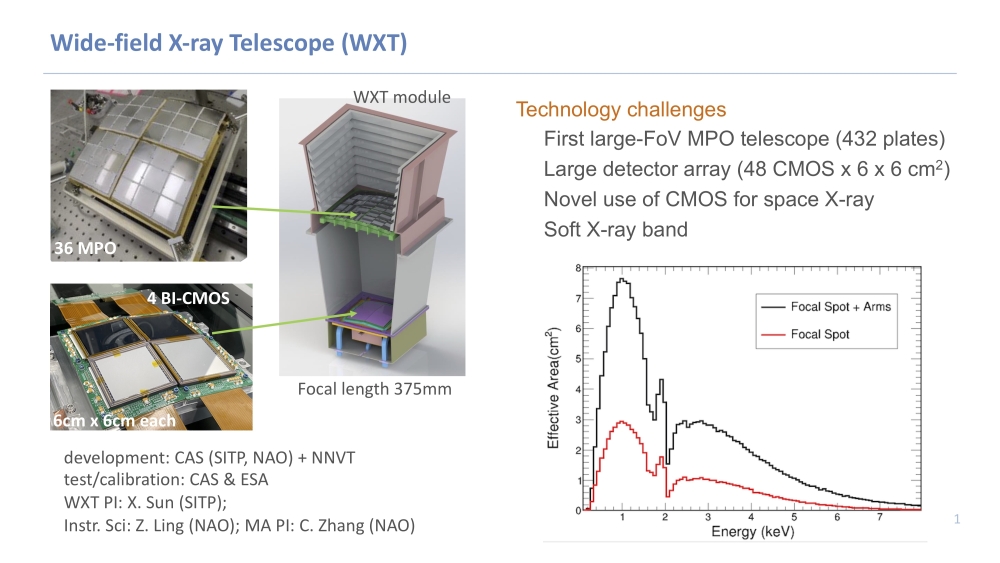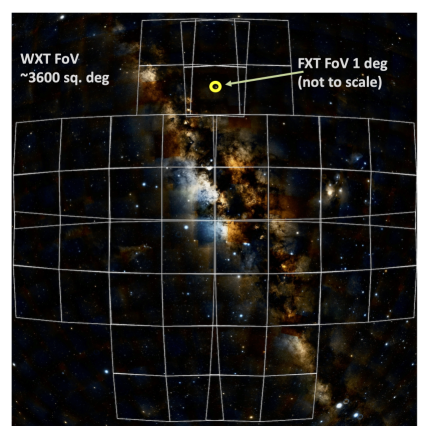InFocus · 30 Aug 2022
To Secure a Safe and Effective Flight
To Secure a Safe and Effective Flight
—An Interview with Dr. ZHANG Chen, PI of WXT mirror assembly for Einstein Probe mission
Editor’s note:
Covering an unprecedentedly wide field of view (FoV) up to 3600 square degrees, the Wide-field X-ray Telescope (WXT) to fly aboard the Einstein Probe (EP) satellite will perform all-sky surveys for high-energy transients. Days ago, the EP team released the first results from the in-orbit experimental observations by a test module (covering a 340-square-degree FoV), which demonstrate the excellent performance of the device. What has made this possible is a special optical system powered by a technology called the lobster-eye micro-pore optics (MPO). The development of this very important system is in the charge of Dr. ZHANG Chen, Principal Investigator of the WXT mirror assembly. He works as a representative for the science team in the engineering work to make sure the instrument is meeting the preset scientific requirements. How challenging is it to build this payload? How does the team secure the accuracy? Let’s hear what Dr. ZHANG said on instrument calibration back in a talk with BCAS Editor SONG Jianlan occurring in late 2021, when the team was developing qualification models for the WXT.

Illustrated are the two major payloads of EP, WXT and FXT. WXT will meet the requirements for all-sky monitoring, while the FXT will meet the demands for follow-up observations once a target of interest is detected. (Image by EP Team)
BCAS: Hello Dr. ZHANG, happy that eventually you’ve got the time to have a brief talk with us. We saw that days ago you excitedly shared on WeChat the image of “the first light” of the WXT. Seems that the project has been going very well, hasn’t it? What exactly does “the first light” mean for WXT?
ZHANG: You know, among astronomers there is some superstitious belief — if the first light of an instrument is good enough, it will herald a smooth running of the whole system and the following observations. Therefore, you can tell how happy we could have been seeing the first light — the well-focused image clearly giving the detail of the X-ray point source, after prosper calibration.
Yes, judged from the characteristic spectrum of the point source reconstructed from the image, the WXT module being tested was working well enough to meet the requirements. After a comparison with the known spectral characteristics of the source, we can say that.

Left: “The first light” image produced by a qualification WXT module under test, as shared by Dr. ZHANG. Right: Mosaicked X-ray images of one point-source from 11 x 11 directions within one-quarter of the FoV (9 degree × 9 degree) of a WXT module. (Images by EP Team)
BCAS: How did you calibrate the modules? Why do we need to calibrate them?
ZHANG: We made the experiments on the campus of the Institute of High Energy Physics (IHEP) of the Chinese Academy of Sciences (CAS), where they have a piece of equipment located in a 100-meter long vacuum tube to generate and emit electron beams. We used high-energy electron beams to bombard a copper target to produce X-rays, and in turn used the X-rays as point-sources to test the modules. Given that the input signals were in strict control and hence well-known, we can open up the black box and figure out how the module responds to the signals, whether or not it behaves as theoretically predicted. The bombarded copper target gives off X-rays that precisely cover a single wavelength — in other words, it emits monoenergetic photons, of which all parameters including spectral characteristics are thoroughly understood. After testing many times, we can know exactly what will happen all through the way the photons travel in the module, judging from the output signals. Only after these repeated tests, can we know whether the instrument meets the requirements and what exactly will happen once the satellite flies and makes its surveys; and only when we know very precisely how the output signals are produced, can we reconstruct the source signals. That’s calibration. Before putting into use, any instrument needs to be calibrated, even as simple as a ruler — you need to measure it with a ruler that is already marked with accurate scales to know how distant is a centimeter on it, and label it with precise scale marks.
BCAS: The engineering development of EP is now in Phase C, right?
ZHANG: Well, the procedure for a mission’s engineering development in China might be a bit different from that in Europe. We are now building the prototype sample of EP — yes, you can say that we are now at some stage equivalent to Phase C. Before being formally adopted in late 2017 as a mission under the umbrella of the Strategic Priority Program for Space Science of CAS, EP had finished the R&D for its demonstration prototype, and verified that the designed instrument can meet the scientific objectives of EP. This is roughly equivalent to the latter half of Phase B in ESA system. In other words, by the time when EP was officially adopted, it had entered the latter half of Phase B if viewed from an ESA perspective; and now it is undergoing a stage roughly equivalent to Phase C — though with some difference — to produce a prototype sample. After this, we will enter Phase D*, in which we are to build a satellite for real flight.
BCAS: So, we are now building qualification models for the WXT module. What are the major tasks for this stage?
ZHANG: At this stage, we are to go through all the scientific and technological procedures and check it out if the system works well enough, and how reliable it is. During the process, we debug and adjust wherever needed to streamline the prototype sample, and make sure it meets all the technical requirements. This might be the last chance for us to correct possible mistakes. You know, once launched, we can do nothing for remedy.
As mentioned above, we need to calibrate the instrument to make sure its performance is good enough to meet the scientific objectives. On the other hand, to make sure the satellite can endure the harsh physical condition during the launching as well as its in-orbit operation — for example the vibration and shocks when it is being carried by the rocket and being thrown into the orbit — we put it under 1.5 times harder conditions in the experiment. After all the procedures, if the qualification models are verified to meet all the preset requirements, we can move onto the next phase, the Phase D, to make a real satellite for flight. 
Structure of the WXT (Image by EP Team)
BCAS: How challenging is it to develop the WXT payload? Particularly, the MPO plates?
ZHANG: Yeah, it is challenging. EP is the most complicated scientific satellite we have ever built. The optical system, featuring the lobster-eye MPO plates, is the most difficult part, as it is the first time for us to build an optical system with so big an FoV – we have no forerunner to follow, and have to feel our way in the dark. There exist some instruments using MPO, but none of them has such a big FoV, nor do they need to meet such harsh requirements as for performance. One single WXT module covers a FoV of over 324 square degrees, and all the 12 modules altogether give an overall FoV of over 3600 square degrees; this means that all the plates need to be produced at extreme accuracy to secure its performance. The plates need to be produced under careful, refined control, to achieve a mechanical processing accuracy of micron order. Not just the optical system, the CMOS detector is also a big challenge. It is the very first time for us to build a detector of so big a focal plane.
Moreover, the WXT integrates lots of state-of-the-art technologies, this further adds to the difficulty. Most components, including the optical system, the detector, the CPU, and even the algorithm as well as the software, are invented and produced ourselves, with the only exception of FPGA system. The supportive system for FPGA system is also developed by us; the assembly and integration are also very difficult given the complicated design.
In the process of the development and calibration, we made a lot of improvements.

The FoV of WXT (overlayed on an optical image of the Galactic plane) (Image by EP Team)

Left: A mirror assembly for the WXT module. Right: CMOS detector array of the WXT module built at SITP/CAS. (Images by EP Team)
BCAS: As scheduled, EP is to finish the prototype sample development and calibration by the end of this year, and move onto Phase D to build the flight model. What do we need to do in Phase D? How far is it from the launch?
ZHANG: During the Phase D, we need to copy the prototype modules, assembly them together and get through required tests and calibration to make sure it can work as a real satellite. The workload is tremendous, as the WXT contains 12 modules, 6 times the number we developed during Phase C; moreover, as a space mission, the satellite needs to meet very severe requirements in terms of reliability. Generally speaking, Phase D goes more smoothly than Phase C, but still we will need to overcome a lot of difficulties.
Another important payload, the optical system for FXT is to meet very harsh requirements of accuracy. It is now being built by the European Space Agency and the MaxPlanck Institute for Extraterrestrial Physics. They are doing very well and now approaching the end of Phase C. We are expecting them to enter Phase D smoothly. The supporting system of FXT is being developed by our colleagues at IHEP.
At last, before launching, the team at the Innovation Academy for Microsatellites of CAS will install all the payloads onto the satellite platform and perform needed debugging and adjustments. Their tasks include experiments to secure the thermal balance of the overall system, which is critical for the instrument’s working condition. The satellite, once launched, working in-orbit it needs to maintain within a reasonable temperature range, not too hot nor too cold, unless the instrument would be destroyed. This requires that the thermal energy produced and consumed by the system keep in balance. To meet this end, different components of the satellite, including the battery pack, need to be designed and arranged smartly, put in a reasonable power ratio. The team there plays an important role in securing the satellite’s performance.
All these done, we will be seeing EP fly into space for its journey of discovery.

Thermal balancing test for a qualification model of the WXT module at SITP/CAS (Image by EP Team)